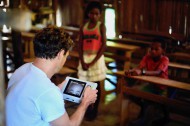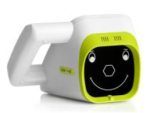Publications
Comparaison Plusoptix, 2WIN et SPOT
"Le Plusoptix surclasse le SPOT et le 2WIN en temps qu'autoréfractomètre..."
"The PlusoptiX outperformed the SPOT and 2WIN as an autorefractor, particularly with respect to astigmatism power and axis."
< Abstract >
Comparaison entre la réfraction non cycloplégique à distance avec le PlusOptix A09 et la réfraction sous cycloplégique. (A. Payerols, C. Malrieu-Eliaou, M. Villain, V. Daien)
"La réfraction mesurée par le PlusOptix est plus proche de la réfraction sous cycloplégique qu'une réfraction classique sans cycloplégique."
< http://www.afsop.fr>
Performance of the Plusoptix vision screener for the detection of amblyopia risk factors in children.
"Conclusion: The PlusoptiX vision screener is a useful tool for the detection of amblyopia risk factors in pediatric population. It is a non invasive, quick, objective, used easily and portable device which provides an accurate fast way to detect amblyopia risk factors as the software automatically evaluate the refractive error and ocular alignment and gives a simple referral grade. PlusoptiX may offer a reasonable way of providing large scale vision screening at relatively low costs."
< Abstract >
Publication scientifique effectuée avec le plusoptiX S04 et S08, (prédécesseur du plusoptiX S09)
Validity of Plusoptix S04 photoscreener as a vision screening tool in children with intellectual disability
"Results: [...] Only 2.5 % of patients did not cooperate with screening device."
"Discussion: Sensitivity and specificity suggests the instrument is accurate as noncycloplegic refractive error screening device in this group of children with high rate of amblyogenic refractive error."
"Conclusion: Children with ID will benefit from mass screenings and Plusoptix S04 is quick, non invasive, portable and accurate that may be useful in special education schools."
Silay Canturk Ugurbas MD; Atilla Alpay MD; Hüseyin Tutar MD; Haci Murat Sagdik MD; Suat H. Ugurbas MD, Zonguldak Karaelmas University Faculty of Medicine, Department of Ophthalmology, Zonguldak, TURKEY
<Abstract>
Detecting Small Angle Strabism With The Plusoptix Photoscreener
"Conclusion: The utility of the plusoptiX system in amlyopia screening programs could be enhanced by adding a strabismus detection capability to the existing photorefractive capability through modifications to the software algorithm."
by Brian W. Arthur MD; Jacky Yeung MD; Christina Leung MD; Karim Rahim PhD, Queen's University, Kingston, Ontario, CANADA
<Abstract>
Vision Screening in pediatrics by Plusoptix Vision Screener compared with standard ortoptic assessment
"Conclusion: When evaluating children in the age group who are most likely to require automated photo screening technology and who will benefit from mass screening, the plus optix screener is very useful tool, it is none invasive, quick, objective, used easily and portable device that provides the added benefit of software able to interpret the results immediately.
It is also seems to be a useful tool for the medical mission work & vision screening programms which likely will find this a useful option in pediatric examination."
by Dr. Ahmed Alaa Aldein, Senior ophthalmologist, Alyamamh Hospital, Riyadh, SAUDI ARABIA
<Display version>
Performance of the plusoptiX S04 photoscreener for the detection of amblyopia risk factors in children aged 3 to 5
"Results: [...] By using these results as our standard, we calculated that the plusoptiX S04 photoscreener offered a sensitivity of 99%, specificity of 82%, false-positive rate of 18%, and false-negative rate of 1.2 %".
"Conclusions: [...] Sensitivity and specitivity suggests that testing the plusoptiX S04 for applications in a general screening environment should be considered."
Journal of AAPOS 2010; 14, pages 147 - 149
<Display version>
Comparison between the plusoptiX and MTI Photoscreeners
"Results: [...] The plusoptiX demonstrated a sensitivity of 98.9%, specificity of 96.1%, false-positive rate of 3.7%, false-negative rate of 1.0 %, and positive predictive value of 97,9%".
"Conclusion: The MTI and the plusoptiX photoscreeners proved to be effective when compared with a comprehensive cycloplegic pediatric ophthalmic examination. The plusoptiX, however, was found to have a higher sensitivity and specitivity than the MTI."
Arch Ophthalmol/Vol 127 (No. 12), Dezember 2009; 14, pages 1591 - 1595
<Display version>
Field testing of the PlusoptiX S04 Photoscreener
"Results: Sensitivity in detecting amblyopiogenic factors was 83%, specificity was 94%".
"[...] children were [...] by assistants from a local Public Health Unit."
"The accuracy of the PlusoptiX SO4 camera in detecting amblyopiogenic factors appears sufficiently high to consider its further deployment in a widespread school screening program."
Journal of AAPOS 2009; 13, pages 51 - 57
<Abstract>
Performance of the PlusOptix vision screener for the detection of amblyopia riskfactors in children
"Results: The PlusOptix vision screener [...] with sensitivity and specificity [...] were 98%, 88% [...]."
"The PlusOptix vision screener is a useful tool for the detection of amblyopia risk factors in pediatric populations."
"The PlusOptix vision screener provides an accurate, fast, user-friendly, and portable way to detect amblyopia risk factors. Because the software automatically evaluates the refractive error and ocular alignment and gives a simple referral grade, the PlusOptix screener may offer a reasonable way of providing large-scale vision screenings at relatively low costs."
"It is portable, user friendly, easy to use on children of all ages, and it
rapidly measures and calculates
accurate and easily understandable data."
Journal of AAPOS 2008;12, pages 490 - 492
<Display version>
Screening for amblyogenic refractive errors with the VisionScreener in a paediatricians' population
"Conclusion:
With a sensititivy of 80 - 90 % and a specitivity of 82 - 95 %, depending on the purpose of the screening and the defined thresholds. the VisionScreener showed to be an effective screening method. [...]
It is easy to handle, requires little time for measurements and the children show very good compliance.
There was probably a slight bias in patient selection by the paediatrician and parents (e.g. family history) becuase prevalence if amblyopia was rether high. However sensitivity and specitivity were similar ti our hospital based study."
Poster presentation ESA 2008; Munich
<Display Version>
Pediatric Eye/Vision Screening: Referral Criteria for the PediaVision Plusoptix S04 Photoscreener Compared to Visual Acuity & Digital Photoscreening
"Results: The estimated sensitivity and predictive value and speed of the objective photoscreeners exceed visual acuity testing. The PediaVision photoscreener, in addition, allowed a practical range of referral refractive criteria to be determined and utilized." (page 83)
"The estimated sensitivity/specificity [...] for PlusOptix 67%/94% [...]." (page 86)
"Since amblyopia is an evolving process for many children throughout the critical first decade, AAP does NOT recommend a single age-based vision screen or comprehensive examination, but rather an age-appropriate series of vision screening tests." (page 87)
"...the rapid computer interpretation with age-based, user definable referral criteria makes the PlusOptix S04 a most potent weapon against amblyopia for any program that can obtain them." (page 88)
Binocular Vision & Strabismus Quarterly, Volume 22, Number 2, Second Quarter 2007, pages 83-89.
<Link>
Off-Label use of the Vision Screener to detect small angle strabismus
“Conclusion: Even very young children do accomodate to the Visionscreener held at 1 m distance. Thresholds have to be adjusted to +1 dpt hyperopia for non-cycloplegic measurements in order to get sensitivity and specficity that are useful for mass screening. It is still open, whether these values have to be changed for general-population based amblyopia screening. A study that looks at a population seen by paediatricians is underway.”
02.06.2007, Presentation at ESA (European Strabismological Association) in Myconos/Greece 2007, PD Dr. med. Oliver Ehrt,Ludwigs-Maximilians University, Department of Ophthalmolgy, Munich
<Display version>
Das Erkennen von Medientrübungen und kleinwinkligen Schielen mit dem Vision Screener
“Der Vision Screener ist ein handgehaltenes Videorefraktometer, das zusätzlich binokular die Lage der Hornhautreflexe relativ zur Pupillenmitte anzeigt. Diese Information wird vom Gerät nur genutzt, um bei Augen, die um mehr als 10° von der Orthostellung abweichen, auf einen amblyogenen Faktor hinzuweisen.
Eine manuelle Auswertung des Hornhautreflexausdrucks von 116 orthotropen und 16 kleinwinklig schielenden Kindern (0.5-6 Jahre) ermöglichte zusätzlich mit einer Sensitivität von zirka 80% bei einer Spezifität von 95% kleinwinkliges Schielen von <10° zu erkennen.
Die subjektive Beurteilung des Fundusreflexes erlaubte bei allen 19 Kindern mit Medientrübung oder -unregelmäßigkeiten, diese zu erkennen.”
(29.09.2006, Zeitschrift für praktische Augenheilkunde & augenärztliche Fortbildung, Jg 27, Heft 7, S. 367-370)
<Display version>
Augenuntersuchungen bei Kleinkindern - Eine Pilotstudie
"Zusammenfassung: In einer einfachen Studie, [...], werden 100 Kinder zwischen dem 3. und 4. Lebensjahr in der pädiatrischen Praxis einem Augenfunktions-Screening unterzogen. 7% der untersuchten Kinder hatten eine Amblyopie. Die Resultate zeigen, dass unter Berücksichtigung eines zumutbaren Aufwandes die zu erwartende Zahl von ca. 5-10% der Schwachsichtigen sicher erfasst und einer frühen Therapie zugeführt werden kann. «Objektive Screening-Vorsorgeuntersuchungen» der Augenfunktion bei Kleinkindern können zu einer erheblichen Verbesserung der Sehqualität im Kindes- und Erwachsenenalter beitragen."
FORUMnews, Zeitschift Forum Praxispädiatrie FPP, Sommer 2009, S. 20 - 23
<Display version>
Tags : Publications, vision, cécité, myopie, nocturne, autoréfractomètre, portable, réfraction, diamètre pupilaire, distance, interpupilaire, strabisme, hypermétropie, astigmatisme, sphère, cylindre, Plusoptix, 2WIN, SPOT








